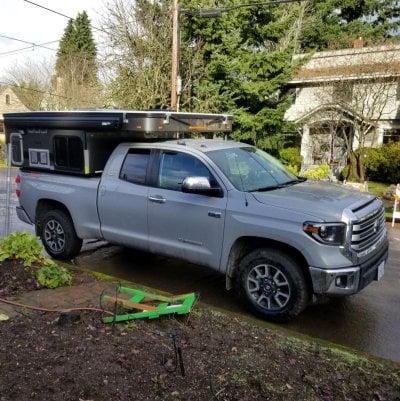I have a 2015 Tundra DBL CAB. First use was to carry a 2014 Hawk slide-in. Upgrade then was rear sway bar, extra rear leaf spring, E rated tires and air bags to balance it all out. Loved it! Second use was to build a flatbed and place a Hawk Flatbed model on it. Upgrade for this was complete OME suspension with two additional leaf springs. Loved it even more.
The truck has tires rotated every 5k miles. The odometer is at 59k and I rotate 5 Michelin 275/65/18E tires. They are the original tires and still show 12/32 of tread depth remaining on the original tires. The oil is changed every 5k miles too and every component is inspected at that time. I am still on the original pads and rotors and they show over 60% pad remaining and no warping on the rotors.
If I was to start over today, I would choose the Tundra again! The rear axel is manufactured by Hino (Toyota Group subsidiary). The rear axel is the same as used in the medium duty trucks manufactured for Japan and Europe. Hino rates this axel at 5500 lbs with a failure rate at 50% over that or right about 8000 lbs. My conclusion is that the 4150 rear GAWR from Toyota is more a function of the P rated tire placed on the truck when built (to provide the American market a cushy ride) than the axel or brakes. The load capacity of the P rated tire is right in line with that rating. Substituting an E rated tire inflated to 80 psi gives you a 5,460 lb working load per tire! Add in the upgraded suspension to “hold up” the load and you keep the front end planted on the ground instead of lifting the weight off of the steering wheels. Throw in some weight up front with a good off road bumper and winch and you improve that distribution too.
But why Toyota? It is a full sized truck that will last “forever”. It is built on a much shorter wheelbase and overall length than the domestic models. The turning radius is tighter, the ground clearance is higher and the angles of approach and departure are better too. If you want to be off road with your truck and camper, then this is the platform to start with in my opinion.
I fully expect this post to bring the “GVW Police” out in full force. I get a lot of amusement by reading all of the dire warnings repeated ad nauseum from these enforcement officers! It seems to me to be more often a repeat of another warning read elsewhere than backed by actual research. Did you know that the modifications mentioned above would allow me to get a new GVW sticker in Australia? The most amusement for me comes from a realization that while most of us here in America constantly rant about wanting less government interference in our lives, it seems to me that the same government interference is OK when it is directed at someone other than ourselves.
Thank you for reading my Sunday morning rant.
This rig is now for sale. You can see it here:
https://www.HawkFlatbed.com . I switched over to a RTT/trailer combo which has it's place but I'm looking at begging forgiveness and crawling back to FWC in a Hawk. My concern is how well a Tundra handles the weight, since it's technically a 1/2 ton truck. I really don't want to get a Tundra and end up having to do tons of suspension upgrades. If that's the case I'd rather cry once and go straight to a 3/4 or 1 ton chariot. I'm probably answering my own question but figured it would be better to hear from real life experience. Thanks in advance!
. I switched over to a RTT/trailer combo which has it's place but I'm looking at begging forgiveness and crawling back to FWC in a Hawk. My concern is how well a Tundra handles the weight, since it's technically a 1/2 ton truck. I really don't want to get a Tundra and end up having to do tons of suspension upgrades. If that's the case I'd rather cry once and go straight to a 3/4 or 1 ton chariot. I'm probably answering my own question but figured it would be better to hear from real life experience. Thanks in advance!
